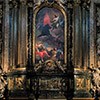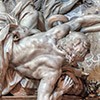The Triumph of Religion Over Heresy by Pierre Le Gros – meaning a Jesuit theatrum sacrum

The Triumph of Religion Over Hersey by Pierre Le Gros, fragment, Chapel of Ignatius of Loyola, Church of Il Gesù

The Triumph of Religion Over Hersey by Pierre Le Gros, Chapel of Ignatius of Loyola, Church of Il Gesù

Church of Il Gesù (transept), altar of Ignatius of Loyola (Cappella Sant'Ignazio)

Altar of Ignatius of Loyola (Cappella Sant'Ignazio), transept of the church of Il Gesù

The Triumph of Religion Over Hersey by Pierre Le Gros, fragment, Chapel of Ignatius of Loyola, Church of Il Gesù

The Triumph of Religion Over Hersey by Pierre Le Gros, fragment, Chapel of Ignatius of Loyola, Church of Il Gesù

The Triumph of Faith over Paganism, Jean-Baptiste Theodon, Chapel of Sant'Ignazio, Church of Il Gesù

Il Gesù church, interior, designed by Jacopo da Vignola
Nothing similar had been seen in Rome before – it was an unbridled expression, an unseen until then storm of eccentric gestures and poses, but also amazing virtuosity. We find ourselves at the end of the nineties of the XVII century. Gian Lorenzo Bernini has been dead for fifteen years, when a new, young sculptor appears in the city on the Tiber, and turns out to be the rising star of Italian art, but also a miraculously revealed continuator of the work of the great Gian Lorenzo.
Nothing similar had been seen in Rome before – it was an unbridled expression, an unseen until then storm of eccentric gestures and poses, but also amazing virtuosity. We find ourselves at the end of the nineties of the XVII century. Gian Lorenzo Bernini has been dead for fifteen years, when a new, young sculptor appears in the city on the Tiber, and turns out to be the rising star of Italian art, but also a miraculously revealed continuator of the work of the great Gian Lorenzo.
And all of this started with a competition organized by the Order of the Jesuits for a sculpting group, which was to adorn one of the altars in the Church of Il Gesù. This imposing, over-a-century-old Jesuit church, was still being decorated and enriched with new altars, paintings, and sculptures. In a chapel found in the left transept of the church, devoted to the founder of the order Ignatius of Loyola, an enormous reredos was designed by a trusted painter of the Jesuits – Andrea Pozzo. The best materials were used to decorate it – lapis lazuli, onyx, amethyst, crystal, gold, and silver, while one hundred artists, craftsmen, and aides worked tirelessly to complete it. The saint's statue, which was previously cast in silver and covered by a painting, is flanked by two monumental columns and adorned by numerous ornaments and reliefs. And all of this makes up the setting for the gilded bronze urn with the remains of Loyola. Additional decoration of the altar was to be made up of two sculpture groups found at its base. One was to show The Triumph of Faith Over Idolatrz and its completion was entrusted to the Frenchman, Jean-Baptiste Théodon. The other entitled The Triumph of Religion Over Hersey was given to a young, unknown sculptor – Pierre Le Gros. The concept of both sculpting groups was once again completed by Andrea Pozzo. At the moment of the competition, Le Gros was a student of the French Academy, where the guidelines assumed that the artist was to work exclusively for the French king. That is why when he entered the competition in 1695, his participation was kept secret, and he was represented by his friend, the engraver Nicholas Dorigny. Only when he received a specific commission and signed the appropriate agreements with the Jesuits did the artist inform the director of the French Academy, Le Teullier. The latter reacted twofold: on one hand, he was angry with the insubordination of his charge, and removed him from the group of students of the Academy, on the other however – he could not hide his pride due to a spectacular victory of the twenty-nine-year-old Frenchman over the crème de la crème of artistic Rome. If that was not enough, the sculpture of his rival Théodon (the author of the group placed on the left side) was altered and corrected numerous times, while the group sculpted by Le Gros was accepted without any remarks or changes, which the director did not fail to emphasize.

Let us then take a look at the group, which clearly greatly impressed the Jesuits, and which at the moment of its unveiling, brought fame to the young Frenchman, making him one of the most sought-after sculptors in the Eternal City.
The personification of Religion with a cross in one hand and flames in the other towers over two falling figures – the personifications of Hersey. We can see an old, frightened woman pulling out her hair, and a man falling into the abyss in an acrobatic pose who is pushing away a hissing serpent stretching his head towards us. And just in case somebody would have doubts which heresy is the one depicted – a putto is ripping out pages from a book with the names of Luther, Calvin, and Zwingli – the greatest enemies of the Roman Catholic Church of those times, and at the same time representatives of Protestantism, which had for good found its niche in the countries of Northern and Central Europe. The Society of Jesus, established in 1540 (the Jesuit Order) which was fully subordinate to the pope, made the struggle against these heresies its principal goal. Despite the efforts of the Jesuits, the Reformation could not be stopped everywhere, however, it was successfully eliminated in countries such as France and Poland. Yet the battle raged on, for every soul, every potential heretic.

The Society of Jesus had since its inception, valued the role of art in its mission and Counter-Reformation propaganda. Its task was to remind the world of the futility of man, but also to warn it against the sin of heresy and eternal damnation. The best evidence of this is frescoes painted at the time on the vault of the main nave of the Church of Il Gesù, which had to inspire the French artist. It is enough to take a look at the middle scene on the vault, painted by Baciccio, in which the light spreading out from the IHS monogram descends onto the earth, setting it free from heresy and paganism. The condemned fall, pulled by demons covering their eyes from the light of true faith. Was it possible to show the triumph of the Roman Catholic Church in a more convincing way? Le Gros has similar ideas. In his work, we can see the same intense emotions, and dynamic space filled with an expression of gestures and theatrical poses. The personification of Religion throwing flames, despite richly draped robes, is almost static in comparison with the convulsively depicted group below. This representation showed the faithful peace, harmony, and stability of true faith, which they could only find in the Roman Catholic Church, as well as the chaos and ugliness found outside its walls. As the man who seems to be falling from the altar. We can see that he will soon fall under our feet, pushed down by Religion's foot. We can have no doubt, that working on this scene the young artist patterned himself after the ancient sculpture Laocoön Group, which he had seen in Rome, and here interpreted in a novel way. Here, in front of our eyes, we see the muscular back of the Trojan priest (Laocoön), while the serpent – in this case, a symbol of sin, with which he struggles – directs his gaze not upon him but on us, ready to strike us with its deadly fangs.

The creation of Le Gros, pulsating with life, which seemed to be created not from chiseled out of marble, but from living figures, appealed to the Jesuits in a particular way. From then on, they would entrust the French artist with subsequent commissions, disregarding the fact that in the then center of the sculpting world, which Rome undoubtedly was, the artists gradually silenced the emotions and expression of their works. However, the Jesuits and their ideological message preferred lively gestures and emotions. Was it possible to present the triumph of the Roman Catholic Church more suggestively and seductively than Le Gross did in the theatrum sacrum that he had created?
The Triumph of Religion Over Hersey by Pierre Le Gros, H 380 cm, D 147 cm, W 314 cm, Chapel of Ignatius of Loyola, Church of Il Gesù




















